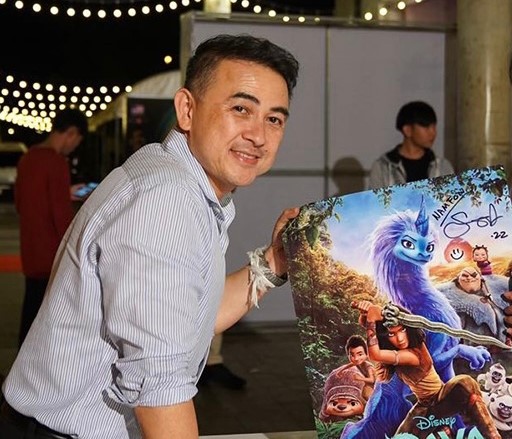Disney’s Raya the Last Dragon Lead Cultural Advisor Reconnects to his Homeland
Source: Vientiane Times
Growing up in the USA, it seems that a small soul was wandering lost and seeking a missing part of himself when, at the age of 16, the boy returned to his motherland of Laos – his first visit since he left the country with his parents at the age of four.
He fell in love with the way of life here and felt like he had found his true home, where he reconnected and realized he had found the missing piece of his soul.
Dr. Steve Arounsack, a Lao-American who is the lead cultural advisor and visual anthropologist for the Walt Disney Animation Studios’ Raya and the Last Dragon, talked about his life during his visit to screen the movie in Laos. The film premiered worldwide in 2021 and became the third most-streamed movie title of 2021.
Arounsack was born in Luang Prabang province but moved to the USA with his family as a child. Like other Lao families living overseas, the children were raised with a knowledge of Lao traditions through the food they ate and the language they heard spoken at home.

We are Your Marketing Partners in Laos
Arounsack loves the Lao food his mother cooks every day and speaks Lao fluently with a Luang Prabang accent.
Arounsack completed a bachelor’s degree in Biology, followed by a master’s in Environmental Science. He was the only Lao-American to qualify for the first cohort accepted in the Gates Millennium Scholars program and earned a Ph.D. in Ecology. His thesis analyzed the ways in which Lao farmers take care of their environment. He is one of the very few Lao-American academics in the US and is a Professor of Anthropology at California State University.
He first returned to Laos almost 30 years ago when his father died, and immediately fell in love with the country.
“I fell in love with the people, their warm hearts, their smiles, kindness, and laid-back attitude to life. When eating, Lao people always call you to join them even if they don’t know you, just as if you were a member of their family,” he said.
His love of the culture, people, and values of Laos and of the Asian region as a whole strengthened year by year and influenced his path in life.
Arounsack frequently visits Laos and neighboring countries to broaden his knowledge and strengthen the bonds he feels.
One day, a wonderful opportunity came his way when Walt Disney Animation Studios decided to make Raya and the Last Dragon – an animation production about Southeast Asian customs and values.
Arounsack became deeply involved in the project and poured his heart into the production process, wishing to tell the world about the wonderful traditions to be found in Asia.
The film portrays several important Lao traditions, including the pervasive use and influence of the khaen bamboo pipe instrument and the ubiquitous use of rice baskets known as thipkhao.
Raya and the Last Dragon tells about the fantasy world of Kumandra, where humans and dragons lived together in harmony. But when sinister monsters known as the Druun threatened the land, the dragons sacrificed themselves to save humanity. Now, 500 years later, those same monsters have returned, and it’s up to a lone warrior to track down the last dragon and stop the Druun for good.
“Southeast Asia is complex and has a rich culture imbued with many special characteristics, while also sharing common traits. The dragon in the film represents the Phayanak, a legendary river-dwelling serpent whose likeness is frequently seen decorating temples and is considered a protector of the people in the region,” Arounsack said.
The film highlights the fragility and importance of trust. One of the most moving quotes is Raya saying, “The world’s broken. You can’t trust anyone.” To which Sisu replies, “Maybe it’s broken because you don’t trust anyone.”
Arounsack said he felt trust was a basic ingredient for community solidarity, adding that people today should have and engender more trust in each other.
At the end of 2022, the film was screened in Vientiane and in Savannakhet and Luang Prabang provinces.
Arounsak is a friendly man who always has a warm smile on his face. He said his family made their first trip to Laos after his father died, to renew their bonds with their homeland.
“Do you know what Samsara means? – it means a never-ending cycle where there is no death and no birth. Even though my father died, it created an opening for another opportunity and when I came to Laos I fell in love with my culture again,” Arounsack said smiling.
“It was the kindness and warm-heartedness of the people that touched me the most, which in Laos we describe as “khon lao mi namchai”, referring to the hospitality of people here,” he said.
Arounsack has traveled extensively and says there is no place like Laos.
“If you drive a car and do something slightly wrong, no one here gets angry. Their attitude is just to say “it’s ok, no problem”, which of course in Lao is expressed as “bor pen yang”. These are wise and calming words, as we don’t want to make someone look bad in public.”
“Laos is a land of gentle people who like to show hospitality and modesty. For example, people in Laos don’t really like to show off or flaunt their achievements like in other countries where people often say “I’m number one in this or that,” Arounsack observed.
After his first visit to Laos, Arounsack began producing the first Lao-American magazine in the USA, called “Lao Visions” (Walassan Sieng Lao).
That was the start of his journey to delve more deeply into Laos’ cultural traditions. He visited various states in the USA to hear people’s stories. He then became fully Lao-American and after that returned to Laos almost every year.
The magazine provided a platform for Lao people to talk to each other, especially as it was founded in the days before the Internet. It was published twice a year and for the first time, Lao people were able to connect with other Lao people in different parts of the country and hear their stories. The magazine brought the Lao diaspora together and Arounsack was very proud of that.
“I watched my parents struggling in the US a bit. When you are a refugee, you don’t know the language when you arrive and things are pretty difficult. But when we came back here I saw how my mother spoke Lao confidently and was able to engage with everyone and be fully independent. That was something very heartwarming for me. When you see the place where your parents fell in love, it made me fall in love again, and I felt like part of a love story between myself and my culture,” Arounsack said.
Arounsack started to speak Lao when he was 16. He taught himself, driven by the fire inside him and his enthusiasm had no limit. So now he is completely fluent and can communicate easily with everyone he meets.


